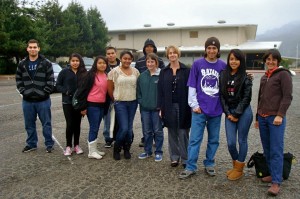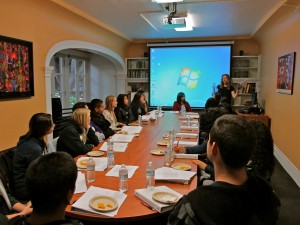Election Day tomorrow, November 6th/Día de elección mañana, el 6 de noviembre
Stanford comes to Pescadero High
Pescadero youth get into Stanford – for high school credit
Stanford University is only an hour’s drive from Pescadero. But it can feel several lifetimes removed from the reality of the isolated South Coast, where most students graduate from Pescadero High with their sights set on community college or a public university.
This year, ten highly motivated students from La Honda and Pescadero are taking classes at Stanford’s Center for Latin American Studies (CLAS) for credit – and getting a taste of real-world university academics, taught by Stanford professors.

The lucky students are enrolled in the Stanford Ambassadors Gateway Exchange Program, a community-based academic partnership that brings local students to the Stanford campus for twelve 3-hour classes over the course of a year.
“It’s hard to imagine what it’s like to be in college unless you’re there,” remarks Suzanne Abel, Academic Director for Puente. “We hope this will help add a challenging new intellectual element to our students’ high school learning experiences. Being at Stanford, learning directly from professors in several fields, our students can open a personal door to the very real possibility of college.”
Thanks to a connection Abel forged between Stanford and the La Honda Pescadero Unified School District, Pescadero High School students were admitted to the program for the first time, joining a group of East Palo Alto Academy High School youth. Abel hoped that at least a handful of students would sign up. But direct recruitment by CLAS faculty and staff, as well as encouragement by high school Principal Pat Talbot and teachers, netted more than that – ten of them.
Best of all is the program itself, which is supported with Title VI funding from the US Department of Education. Students will be studying the entire Latin American hemisphere all year – from the standpoint of history and literature (fall), political economy (winter) and ecology and the environment (spring). Students are bussed in on Thursdays, dinner is provided, and classes are free.
The third quarter’s curriculum on ecology and the environment will be taught outdoors at Stanford’s Jasper Ridge Biological Preserve by Professor Rodolfo Dirzo, director of CLAS. Students will learn about animals and plants of Latin America and what is occurring hemispherically with respect to climate change.
Many students have Latino origins, but Stanford officials “rightly assumed the youth would have some general sense of the region from their high school studies, but not necessarily detailed knowledge much beyond their own family roots,” says Abel. “Besides, it’s a vast region, and there is a lot to know!”

Pescadero High School Principal Pat Talbot and Superintendent Amy Wooliever both jumped at the chance to send students to Stanford this year. So far, Talbot says the program has earned high marks from students.
“I always believe that anytime we can bring the outside world into this isolated district the better,” Talbot says. “I’m really happy that so many students decided to do this.”
Puente is just getting started in building a stronger relationship with Stanford, which also involves faculty whose research interests align with Puente’s needs. This past summer, four Puente youth were selected to participate in the Stanford College Prep program (through the Haas Center for Public Service, where Abel worked for many years).
Stanford medical school student Jessie Liu was a fellow with Puente this summer through the Office of Community Health (OCH), which envisions a long-term partnership in the community and has sent undergraduates to Puente before.
And Puente is in dialogue with the Stanford Office of Science Outreach about nominating one or two students from Pescadero to work in Stanford labs next summer through the RISE internship program (Raising Interest in Science and Engineering).






